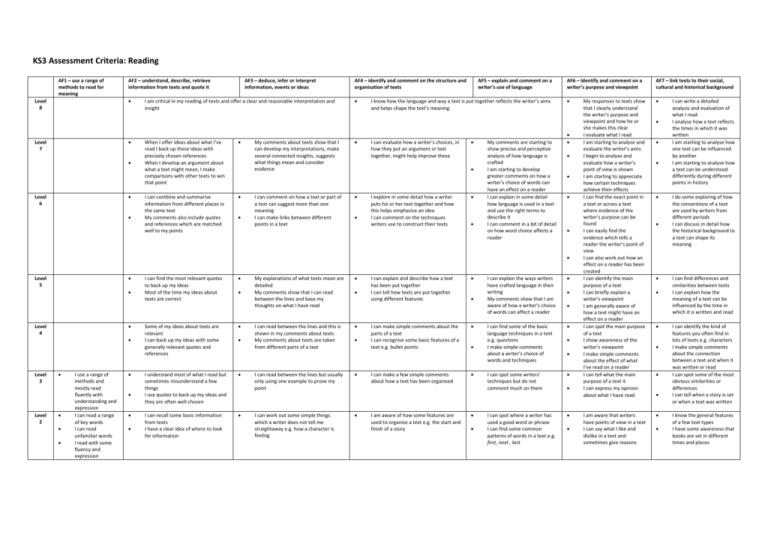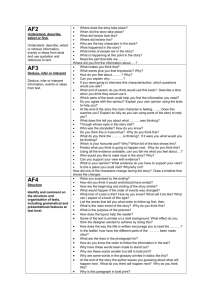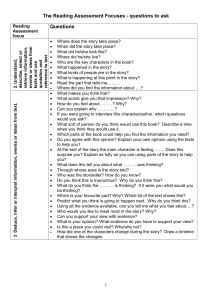KS3 Assessment Criteria: Reading AF1 – use a range of methods to
advertisement

KS3 Assessment Criteria: Reading AF1 – use a range of methods to read for meaning AF2 – understand, describe, retrieve information from texts and quote it Level 8 Level 7 Level 6 AF3 – deduce, infer or interpret information, events or ideas I am critical in my reading of texts and offer a clear and reasonable interpretation and insight When I offer ideas about what I’ve read I back up these ideas with precisely chosen references When I develop an argument about what a text might mean, I make comparisons with other texts to win that point I can combine and summarise information from different places in the same text My comments also include quotes and references which are matched well to my points My comments about texts show that I can develop my interpretations, make several connected insights, suggests what things mean and consider evidence I can comment on how a text or part of a text can suggest more than one meaning I can make links between different points in a text AF4 – identify and comment on the structure and organisation of texts AF5 – explain and comment on a writer’s use of language I know how the language and way a text is put together reflects the writer’s aims and helps shape the text’s meaning I can evaluate how a writer’s choices, in how they put an argument or text together, might help improve these I explore in some detail how a writer puts his or her text together and how this helps emphasise an idea I can comment on the techniques writers use to construct their texts My comments are starting to show precise and perceptive analysis of how language is crafted I am starting to develop greater comments on how a writer’s choice of words can have an effect on a reader I can explain in some detail how language is used in a text and use the right terms to describe it I can comment in a bit of detail on how word choice affects a reader AF6 – Identify and comment on a writer’s purpose and viewpoint AF7 – link texts to their social, cultural and historical background My responses to texts show that I clearly understand the writer’s purpose and viewpoint and how he or she makes this clear I evaluate what I read I am starting to analyse and evaluate the writer’s aims I begin to analyse and evaluate how a writer’s point of view is shown I am starting to appreciate how certain techniques achieve their effects I can find the exact point in a text or across a text where evidence of the writer’s purpose can be found I can easily find the evidence which tells a reader the writer’s point of view I can also work out how an effect on a reader has been created I can identify the main purpose of a text I can briefly explain a writer’s viewpoint I am generally aware of how a text might have an effect on a reader I can spot the main purpose of a text I show awareness of the writer’s viewpoint I make simple comments about the effect of what I’ve read on a reader I can tell what the main purpose of a text it I can express my opinion about what I have read I am aware that writers have points of view in a text I can say what I like and dislike in a text and sometimes give reasons Level 5 Level 4 Level 3 Level 2 I use a range of methods and mostly read fluently with understanding and expression I can read a range of key words I can read unfamiliar words I read with some fluency and expression I can find the most relevant quotes to back up my ideas Most of the time my ideas about texts are correct Some of my ideas about texts are relevant I can back up my ideas with some generally relevant quotes and references I understand most of what I read but sometimes misunderstand a few things I use quotes to back up my ideas and they are often well chosen I can recall some basic information from texts I have a clear idea of where to look for information My explanations of what texts mean are detailed My comments show that I can read between the lines and base my thoughts on what I have read I can read between the lines and this is shown in my comments about texts My comments about texts are taken from different parts of a text I can read between the lines but usually only using one example to prove my point I can work out some simple things which a writer does not tell me straightaway e.g. how a character is feeling I can explain and describe how a text has been put together I can tell how texts are put together using different features I can make simple comments about the parts of a text I can recognise some basic features of a text e.g. bullet points I can make a few simple comments about how a text has been organised I am aware of how some features are used to organise a text e.g. the start and finish of a story I can explain the ways writers have crafted language in their writing My comments show that I am aware of how a writer’s choice of words can affect a reader I can find some of the basic language techniques in a text e.g. questions I make simple comments about a writer’s choice of words and techniques I can spot some writers’ techniques but do not comment much on them I can spot where a writer has used a good word or phrase I can find some common patterns of words in a text e.g. first, next , last I can write a detailed analysis and evaluation of what I read I analyse how a text reflects the times in which it was written I am starting to analyse how one text can be influenced by another I am starting to analyse how a text can be understood differently during different points in history I do some exploring of how the conventions of a text are used by writers from different periods I can discuss in detail how the historical background to a text can shape its meaning I can find differences and similarities between texts I can explain how the meaning of a text can be influenced by the time in which it is written and read I can identify the kind of features you often find in lots of texts e.g. characters I make simple comments about the connection between a text and when it was written or read I can spot some of the most obvious similarities or differences I can tell when a story is set or when a text was written I know the general features of a few text types I have some awareness that books are set in different times and places





